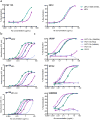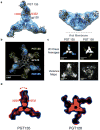Supersite of immune vulnerability on the glycosylated face of HIV-1 envelope glycoprotein gp120
- PMID: 23708606
- PMCID: PMC3823233
- DOI: 10.1038/nsmb.2594
Supersite of immune vulnerability on the glycosylated face of HIV-1 envelope glycoprotein gp120
Abstract
A substantial proportion of the broadly neutralizing antibodies (bnAbs) identified in certain HIV-infected donors recognize glycan-dependent epitopes on HIV-1 gp120. Here we elucidate how the bnAb PGT 135 binds its Asn332 glycan-dependent epitope from its 3.1-Å crystal structure with gp120, CD4 and Fab 17b. PGT 135 interacts with glycans at Asn332, Asn392 and Asn386, using long CDR loops H1 and H3 to penetrate the glycan shield and access the gp120 protein surface. EM reveals that PGT 135 can accommodate the conformational and chemical diversity of gp120 glycans by altering its angle of engagement. Combined structural studies of PGT 135, PGT 128 and 2G12 show that this Asn332-dependent antigenic region is highly accessible and much more extensive than initially appreciated, which allows for multiple binding modes and varied angles of approach; thereby it represents a supersite of vulnerability for antibody neutralization.
Figures






Comment in
-
Antibodies expose multiple weaknesses in the glycan shield of HIV.Nat Struct Mol Biol. 2013 Jul;20(7):771-2. doi: 10.1038/nsmb.2627. Nat Struct Mol Biol. 2013. PMID: 23984441
References
-
- Weiss RA, et al. Neutralization of human T-lymphotropic virus type III by sera of AIDS and AIDS-risk patients. Nature. 1985;316:69–72. - PubMed
-
- Wei X, et al. Antibody neutralization and escape by HIV-1. Nature. 2003;422:307–312. - PubMed
-
- Zhang M, et al. Tracking global patterns of N-linked glycosylation site variation in highly variable viral glycoproteins: HIV, SIV, and HCV envelopes and influenza hemagglutinin. Glycobiology. 2004;14:1229–1246. - PubMed
Publication types
MeSH terms
Substances
Associated data
- Actions
- Actions
Grants and funding
- R01 AI33292/AI/NIAID NIH HHS/United States
- RR017573/RR/NCRR NIH HHS/United States
- R01 AI084817/AI/NIAID NIH HHS/United States
- U54 GM094586/GM/NIGMS NIH HHS/United States
- R37 AI036082/AI/NIAID NIH HHS/United States
- R37 AI36082/AI/NIAID NIH HHS/United States
- UM1 AI100663/AI/NIAID NIH HHS/United States
- U01 CA128416/CA/NCI NIH HHS/United States
- P01 AI082362/AI/NIAID NIH HHS/United States
- R01 GM046192/GM/NIGMS NIH HHS/United States
- P01 AI82362/AI/NIAID NIH HHS/United States
- WT099197MA/WT_/Wellcome Trust/United Kingdom
- P41 GM103310/GM/NIGMS NIH HHS/United States
- 099197/WT_/Wellcome Trust/United Kingdom
- HHMI/Howard Hughes Medical Institute/United States
- P41 RR017573/RR/NCRR NIH HHS/United States
- R01 AI84817/AI/NIAID NIH HHS/United States
- R01 AI033292/AI/NIAID NIH HHS/United States
- WT093378MA/WT_/Wellcome Trust/United Kingdom
- P30 AI036214/AI/NIAID NIH HHS/United States
LinkOut - more resources
Full Text Sources
Other Literature Sources
Molecular Biology Databases
Research Materials

